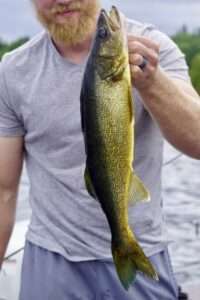 PRATT – In March, Kansas Department of Wildlife, Parks and Tourism (KDWPT) fisheries biologists and other staff collected nearly 100 million walleye eggs. Thanks to the Kansas Walleye Initiative, a record percentage of the walleye and saugeye hatched from those eggs will likely end up on the hooks of Kansas anglers.
PRATT – In March, Kansas Department of Wildlife, Parks and Tourism (KDWPT) fisheries biologists and other staff collected nearly 100 million walleye eggs. Thanks to the Kansas Walleye Initiative, a record percentage of the walleye and saugeye hatched from those eggs will likely end up on the hooks of Kansas anglers.
“We’ve been having some great success, and the program is only four or five years old,” said Scott Waters, KDWPT fisheries biologist and chairman of the walleye committee. “It’s already leading to more catchable walleye.”
The program began in 2015, with meetings between fisheries biologists and a variety of researchers and hatchery staff. Waters was also quick to thank the Kansas Wildlife, Parks and Tourism Commission for ongoing support for the program.
The initiative has led to the following:
Higher survival rate for stocked fingerlings
One of the program’s goals is to increase the size of stocked walleye fingerlings from about 1.25 inches to 1.7 inches, giving fingerlings a chance to develop scales before being stocked and a better chance of survival. The increased size makes it easier for them to find food, and scales protect against fatal infections.
Bigger and better walleye for stocking
The Kansas Walleye Initiative has led to hatcheries implementing an intensive walleye culture process that has increased production of “intermediate” walleyes that are 8 to 10 inches long when stocked. These fish are stocked in the fall, have very high survival rates and are well on their way to being of a desirable size for anglers. Last year, about 20,000 intermediates were produced and stocked in Kansas lakes and reservoirs. Waters said the department’s goal of producing 75,000 intermediate-sized walleye is within sight.
Specialized management plans
Largely depending on their capabilities, reservoirs and lakes are now classified and managed in four categories:
Harvest lakes are managed to allow anglers to harvest walleye or saugeye and have a 15-inch minimum length limit.
Trophy waters are managed to give anglers their best chance at a walleye or saugeye of trophy-sized proportions, using 18- or 21-inch minimum length limits and sometimes reduced creel limits.
Brood walleye lakes are managed to provide good fishing yet a ready supply of healthy walleye eggs for the program.
Biological control lakes are managed to keep good numbers of big walleye and saugeye in the water to help control problematic species, like white perch.
Waters said the plan is to keep at least one lake from each category within an easy drive of most Kansas anglers.
Stocking based on priority and potential
Kansas reservoirs and lakes are now more closely studied and ranked based on walleye or saugeye need and potential. Rather than randomly distributing fish for stocking, fry, fingerlings and intermediates are sent to where they’re most needed, yet likely to survive and thrive.
Funding the project
The Kansas Walleye Initiative’s goals are becoming realities because of significant funding improvement for the state’s walleye hatchery program. High on that list is a $2 million specialized walleye facility being constructed at the Meade Fish Hatchery. Another $225,000 has been spent to improve specialized equipment at the department’s Milford Fish Hatchery. There’s also an annual budget of $280,000 to cover the enhanced feed and energy costs, plus the purchase of fingerlings from private fish producers when needed.
Two full-time employees have been hired specifically for the program and funding to hire part-time employees, when needed, is also available.
Waters said the majority of the funding comes from fishing license revenue and the Dingell-Johnson fund, derived by federal excise taxes placed on fishing gear. D-J grants can only be used on projects that improve fishing and require 25 percent matches, provided by license revenue.
“As usual, everything goes back to the anglers really being the ones who pay for projects,” said Waters. “We should get a really good return on the investment. We see an excellent future.”
https://ksoutdoors.com/




